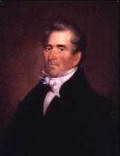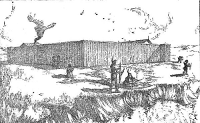Manuel Lisa: Spanish-American Trapper & Trader
Manuel Lisa was a well-known fur trader in early 19th-Century America. Lisa was born Sept. 8, 1772, in New Orleans. The city was, at the time, part of New Spain, and his father was a local government official. 
As a teenager, Lisa got involved in the fur trade; by the time he was 24, he was plying his own fur trading boat up and down the Mississippi River. His brother Joaquin helped him in this. Also at this time, he married Polly Chew. They had two sons, Raymond and Manuel. Lisa obtained a land grant in 1799, then relocated to St. Louis the following year. The government granted him sole trading rights with the Osage. Lisa provided supplies to the Lewis and Clark expedition as the Corps of Discovery was getting ready to make their famous journey west. When they all met again, Lisa was so impressed by their tales of great opportunities for fur trading that he made arrangements to capitalize in the opportunity and, in 1807, set out on an expedition of his own, with two larger boats and more than 50 men. The Lisa expedition went up the Missouri River and then Yellowstone River and reached the mouth of the Bighorn River; at that point, Lisa and his men set up a trading post. A year later, they built a fort, which Lisa named Fort Raymond, after his son. Lisa's trading outfit became successful, despite regular harassment by Native Americans. One of America's most famous Mountain Men, John Colter, was a feature at this fort for a few years. In 1809, Lisa went into business with Clark, Andrew Henry, and Jean Pierre Chouteau to form the St. Louis Missouri Fur Company. Their target was the area around the upper Missouri River. They enjoyed some initial success and had some sustained success. However, a combination of Native American hostility and the outbreak of the War of 1812 convinced the owners to close up the company, in 1814. 
Lisa built a fort just north of what is now Omaha, Neb., and named it after himself. He accepted an 1814 appointment by Clark, who had become governor of the Missouri Territory, to be a liaison to Native American tribes around the mouth of the Kansas River. He helped relations in this regard by marrying Mitain, a woman whose father was Big Elk, the head chief of the Omaha tribe. (This is was not an uncommon occurrence in this area at this time.) Lisa and Mitain had two children, Rosalie and Christopher. Lisa's original wife, Polly, died in 1817; two years later, he married again, to Mary Keeney, who became the first European women to visit Nebraska when she joined him at Fort Lisa in the winter of 1819–1820. He briefly resurrected the Missouri Fur Company, but it didn't go well. Lisa became ill and returned to St. Louis. He died there on Aug. 12, 1820. He was an influential fur trader in that subsequent traders employed many of his methods in pursuing their trade. |
|
Social Studies for Kids
copyright 2002–2025
David White





